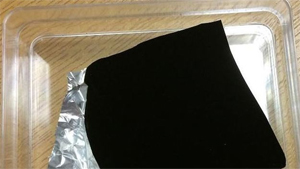Color…… What do we mean when we say an object is “red”, or “blue” or “black”.
We see an object’s color as the color of light that it reflects. A red shirt is red because it reflects (bounces back) red light (and absorbs all other colors). And blue pants are blue because they reflect blue light (and absorb all other colors). And if an object reflects ALL light, we call it white. And if an object does not reflect any light, we call it black. Black objects absorb all the light that falls on them. Black is the ultimate dark color.
 But can anything be truly black, that is, absorb all light of all colors. And the answer is no, even the blackest black reflects just a little bit of light. In really, everything we see as black is just some really really really dark shade of grey!
But can anything be truly black, that is, absorb all light of all colors. And the answer is no, even the blackest black reflects just a little bit of light. In really, everything we see as black is just some really really really dark shade of grey!
But, using nanotechnology, scientists in England have succeeded in making the blackest material ever. They call it “Vantablack”, and it absorbs 99.96% of all light that falls on it. This ultra-black material is formed by coating the surface with nanotubes. Nanotubes are tiny tubes of carbon atoms; Vantablack material consists of a dense forest of carbon nanotubes. Light gets trapped between all the nanotubes and is ultimately absorbed, with very very little reflection. The result is a surface that is weirdly black, very black. And because we sense texture and shape by reflected light, it is a surface that looks very very flat even when it isn’t.
So what is it good for? It would be a lot of trouble to go through just to have car that was blacker than everyone else’s. But scattered light really is a problem in various scientific instruments, for example, in telescopes. Using Vantablack to coat sensitive optical instruments can greatly improve their sensitivity.
Who would have thought that there was something to invent about “black”.
